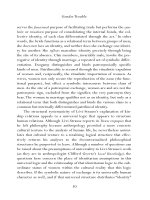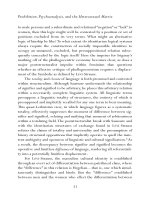GENDER TROUBLE 101
Bạn đang xem bản rút gọn của tài liệu. Xem và tải ngay bản đầy đủ của tài liệu tại đây (20.45 KB, 1 trang )
Gender Trouble
the desire of the mother, as one might expect, but over the place of the
father in public discourse as speaker, lecturer, writer—that is, as a user
of signs rather than a sign-object, an item of exchange. This castrating
desire might be understood as the desire to relinquish the status of
woman-as-sign in order to appear as a subject within language.
Indeed, the analogy that Riviere draws between the homosexual
man and the masked woman is not, in her view, an analogy between
male and female homosexuality. Femininity is taken on by a woman
who “wishes for masculinity,” but fears the retributive consequences of
taking on the public appearance of masculinity. Masculinity is taken on
by the male homosexual who, presumably, seeks to hide—not from
others, but from himself—an ostensible femininity. The woman takes
on a masquerade knowingly in order to conceal her masculinity from
the masculine audience she wants to castrate. But the homosexual man
is said to exaggerate his “heterosexuality” (meaning a masculinity that
allows him to pass as heterosexual?) as a “defense,” unknowingly,
because he cannot acknowledge his own homosexuality (or is it that
the analyst would not acknowledge it, if it were his?). In other words,
the homosexual man takes unconscious retribution on himself, both
desiring and fearing the consequences of castration. The male homosexual does not “know” his homosexuality, although Ferenczi and
Riviere apparently do.
But does Riviere know the homosexuality of the woman in masquerade that she describes? When it comes to the counterpart of the
analogy that she herself sets up, the woman who “wishes for masculinity” is homosexual only in terms of sustaining a masculine identification,
but not in terms of a sexual orientation or desire. Invoking Jones’s
typology once again, as if it were a phallic shield, she formulates a
“defense” that designates as asexual a class of female homosexuals understood as the masquerading type: “his first group of homosexual women
who, while taking no interest in other women, wish for ‘recognition’ of
their masculinity from men and claim to be the equals of men, or in
other words, to be men themselves” (37). As in Lacan, the lesbian is
66









